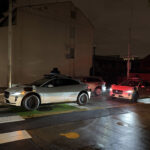Preliminary readings of black box data recovered from a French Airbus plane that crashed in the Atlantic have eased any immediate concerns over the safety of A330 aircraft, but investigators warned on Tuesday against rushing to blame the crew for the 2009 disaster.
French investigators are pouring over data and cockpit voice recordings from two black boxes hauled up from the seabed after an agonizing two-year wait, and are under pressure to solve the mysterious loss of an Air France jet that killed 228 people.
In a statement, France’s BEA air accident investigation agency reiterated it was too early to draw any conclusions about what caused the dramatic disappearance in a storm of flight 447 on June 1, 2009, while en route from Rio de Janeiro to Paris.
But it said the successful retrieval of black box flight data and cockpit recordings “make us almost entirely certain today that all light will be shed on this accident.”
The two devices deemed to contain vital clues about the crash were recovered earlier this month and arrived in Paris on Thursday. The BEA said on Monday all of the data was intact.
In the first tangible indication of where investigations may be leading, Airbus told airlines on Tuesday that it had no new safety recommendations as a result of the first examination of the flight data recorder, sources familiar with the matter said.
Although not released to the public, such industry-wide messages are usually seen as significant because they can only be issued with the approval of official crash investigators.
Any obvious defect would automatically lead to some form of recommendation to avoid risking passenger safety on the rest of the 1,000 or so A330 aircraft in service across the world.
“At this stage of the preliminary analysis of the DFDR (digital flight data recorder), Airbus has no immediate recommendation to advise operators,” the European plane maker said in an industry bulletin obtained by Reuters.
The bulletin did not rule out any recommendations later.
Airbus declined to comment.
CREW REPORT DISMISSED
Passenger aircraft carry two devices to help experts in the event of a crash — a data recorder that tracks systems and changes in aircraft behavior, and a loop containing cockpit conversations, in this case covering the last two hours before the crash.
The BEA has said analyzing the data will take some weeks. Specifically, the investigation team has yet to synchronize readings from the data recorder with the cockpit voice recordings, a crucial, but time-consuming process.
The BEA reacted angrily to a French newspaper report that pointed the finger directly at Air France or its crew, calling it “sensationalist” and premature.
Citing French government sources and people close to the investigation, Le Figaro reported that experts had singled out crew error but had not determined whether any mistake resulted from their decisions or Air France’s own procedures.
Representatives of some of the victims’ families have asked why the Air France jet, one of several flying to northwest Europe from Brazil, flew through an equatorial storm while some other aircraft crossing chose a slightly different route.
Weather officials said shortly after the disaster that two aircraft of German airline Lufthansa had passed through the same area as the doomed Air France plane at around the same time without any incident. Storms are common where the route crosses the equator.
The outcome of the investigation has potentially significant legal implications for both the plane manufacturer and airline.
But investigators have repeatedly warned against trying to read too much into individual scraps of information, including inconsistent readings from aircraft speed sensors which dominated the earliest phases of the investigation.
(Editing by James Regan and Mark Trevelyan)
Was this article valuable?
Here are more articles you may enjoy.


 Waymos Froze, Blocked Traffic During San Francisco Power Outage
Waymos Froze, Blocked Traffic During San Francisco Power Outage  CEO Sentenced in Miami to 15 Years in One of the Largest Health Care Fraud Cases
CEO Sentenced in Miami to 15 Years in One of the Largest Health Care Fraud Cases  Injured Pedestrian Strikes Out on PIP Benefit Because Car She Dodged Never Struck Her
Injured Pedestrian Strikes Out on PIP Benefit Because Car She Dodged Never Struck Her  Senators Launch Probe Into Demotech’s Ratings in Florida
Senators Launch Probe Into Demotech’s Ratings in Florida 

